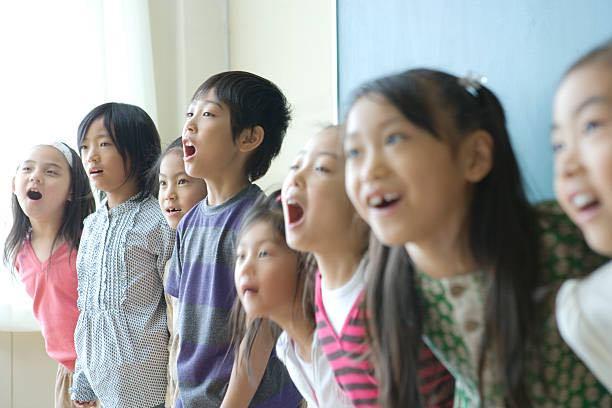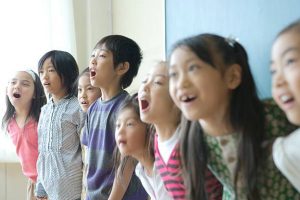Are you wondering how to find fun and age-appropriate vocal warm ups for kids? Teaching young voices presents a unique challenge to voice teachers. As singers, our body is our instrument, and we work to develop muscle memory in a way that supports good vocal technique and healthy singing. However, younger students are working with an instrument that is not fully developed. It is unwise to train young voices in the same way we train adult voices, as their physical instrument is going to change in major ways.
Teaching true vocal technique to children can be counterproductive, and even harmful. Our aim in training young students should be first and foremost about preservation of the voice, and healthful singing. Our second aim should be about instilling in these students a love for singing while also teaching basic musicianship skills. This brings us to the challenge of developing vocal warmups for kids that are both educational and fun.
Silly Sounds and Tongue Twisters
Even though we don’t teach true vocal technique to young voices, vocal warmups for kids should still teach some very basic concepts, such as breathing for singing. Part of preserving the young voice has to do with guarding against the development of bad habits or anything that causes physical tension in the body. Exercises that teach kids to simply make sure their air is moving through their sound creation are ideal. These exercises can be done by making “silly” sounds, such as lip trills, or voiced consonants, such as “v,” “tz,” or “z”. Because continual air flow is necessary to sustain these sounds, they are a good indication of whether or not students are infusing ample air into their phonation.
Another fun vocal warmup for kids involves the use of tongue twisters or nonsense words. These accomplish an additional goal of making sure kids are articulating clearly while singing, and creating a good balance between consonant and vowel formation. Some examples of these include singing a five note descending scale on the phrase “Zing-a-ma-ma.” Another example would be singing a five note scale (ascending and descending on the phrase “no-me-no-me-no”. These are just a few examples. Teachers can get creative and turn any silly phrase or tongue twister into a vocal warmup that kids can enjoy, while also serving the purpose of getting the articulators moving.
Musicianship Training
Vocal warmups for kids should serve a dual purpose of not only promoting healthy, fun singing, but also teaching kids basic musicianship skills. Teaching these skills early in life is especially beneficial to creating strong musicians with well-trained ears. I encourage students to learn to sing a major scale on solfège syllables (do-re-mi-fa-sol-la-ti-do). Once they can confidently sing this scale, both ascending and descending, I have them move on to singing triads on solfège syllables (do-mi-sol-mi-do).
As young students gain more familiarity with solfège, it is possible to incorporate more complex solfège patterns into vocal warmups, including triads with qualities other than major. I have my younger students sing a minor triad on solfège as a way to start a discussion about how the change of quality can change the feeling of a piece of music. Gaining familiarity with solfège syllables is challenging, but can also be a good way to get students thinking about melodic vocal lines in new ways, and help them to develop strong ear training skills that will serve them well as they continue their music training.
Rhythm and Movement
Incorporating movement into vocal warmups is one of the most critical pedagogical methods I use for teaching young voices. Movement with singing accomplishes various goals. First of all, it gets students accustomed to the idea of using their whole body to create sound. This lays the foundation for free singing and strong breath support as they get older. Second, movement can be a great way to help students feel musical rhythm in their bodies. This can help them learn about keeping time, which can eventually lead to a more instinctual understanding of concepts such as time signatures in music.
One such exercise is to have students clap and stomp their feet while counting on each beat. Starting with a simple four-beat pattern, students clap on each beat (1-2-3-4) but step or stomp their feet only on beat one. This can help students gain an understanding for keeping a steady rhythm or tempo in singing, as well as feeling the strength of the downbeat of each measure. Incorporating clapping and movement along with counting helps students internalize the pattern. The same exercise can be done for other time signatures, counting 1-2-3, 1-2-3, or 1-2, 1-2.
While all of the above exercises serve specific pedagogical purposes and help solidify musical concepts for young students, they also bring fun into lessons, and instill joy into the necessary process of warming up the voice. Vocal warmups for kids should get young students thinking about music and singing in new ways, and should help them to understand that warm-ups are not just for the voice but for the body and mind as well. With this in mind, we can help students develop strong musicianship skills and a love for music that will last them their entire lives.
Pamela Stein Lynde


